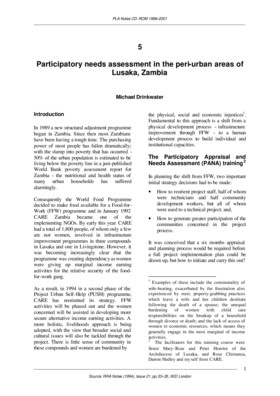PLA Notes CD-ROM 1988-2001 5 Participatory needs assessment in the peri-urban areas of Lusaka, Zambia

Document begins: PLA Notes CD-ROM 19882001 5 Participatory needs assessment in the peri-urban areas of Lusaka, Zambia Michael Drinkwater Introduction the physical, social and economic injustices1. Fundamental to this approach is a shift from a In 1989 a new structural adjustment programme physical development process - infrastructure began in Zambia. Since then most Zambians improvement through FFW - to a human have been having a tough time. The purchasing development process to build individual and power of most people has fallen dramatically; institutional capacities. with the slump into poverty that has occurred - 50% of the urban population is estimated to be The Participatory Appraisal and living below the poverty line in a just-published Needs Assessment (PANA) training2 World Bank poverty assessment report for Zambia - the nutritional and health status of In planning the shift from FFW, two important many urban households has suffered initial strategy decisions had to be made: alarmingly. · How to reorient project staff, half of whom Consequently the World Food Programme were technicians and half community decided to make food available for a Food-for- development workers, but all of whom Work (FFW) programme and in January 1992 were used to a technical project; and, ...
Cite this publication
Available at https://www.iied.org/g01542